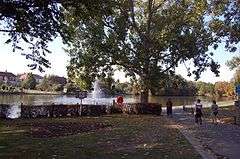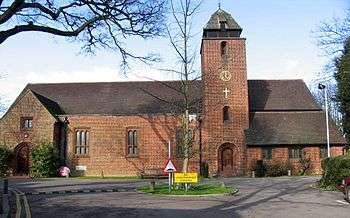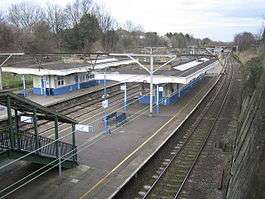Gidea Park
Gidea Park (/ˈɡɪdiə/) is a neighbourhood in Romford in the London Borough of Havering, England. Predominantly affluent and residential, it was originally known as Romford Garden Suburb.
| Gidea Park | |
|---|---|
 Raphael public park in Gidea Park | |
 Gidea Park Location within Greater London | |
| OS grid reference | TQ525905 |
| • Charing Cross | 15.2 mi (24.5 km) ENE |
| London borough | |
| Ceremonial county | Greater London |
| Region | |
| Country | England |
| Sovereign state | United Kingdom |
| Post town | ROMFORD |
| Postcode district | RM2 |
| Dialling code | 01708 |
| Police | Metropolitan |
| Fire | London |
| Ambulance | London |
| UK Parliament | |
| London Assembly | |
Locale
Gidea Park is south-west of the Gallows Corner junction where the A12, A127 and A118 roads meet. It is approximately 15 miles (24 km) north-east of Charing Cross.
Romford town centre is to the south-west of Gidea Park; Ardleigh Green is to the east, and Emerson Park and Hornchurch are to the south.
History
Thomas Cooke, a Yorkshireman who became London Mayor in 1462, was granted a Royal Charter for Royal Liberty of Havering-atte-Bower, which enabled him to build a country house, which he named "Geddy Hall". The word "geddy" was so named after the lake and its livestock; ged, meaning pike, and ea (water). The house remained unfinished for at least a century, because of his numerous incarcerations within the Tower of London for High Treason. Upon his death in 1478, the estate was passed down through the Cooke family and eventually to his great-grandson, Anthony Cooke, who was a tutor for Edward VI.[1] After a brief period abroad, Anthony returned to Havering-atte-Bower and completed the building of Geddy Hall, which became Gidea Hall.[2] In 1657, the hall and its grounds were sold to Richard Emes, a local businessman, for £9,000. Upon the Restoration, the estate was bought back by the Crown and passed through the ownerships of various nobilities, before eventually being sold through public auction, shortly before the Coronation of Queen Victoria.[3]
Romford Garden Suburb was constructed in 1910–11 on the Gidea Hall and Balgores estates as an exhibition of town planning. Small cottages and houses were designed by more than 100 architects, many of them of considerable reputation. A competition was held to select the best town planning scheme for the suburb; the best designs for houses resulted in those being sold at a well-above average £500 and cottages at £375. The project, including a new railway station on the Great Eastern Main Line out of London, was promoted by a company founded by three Liberal Members of Parliament who had links with the Hampstead Garden Suburb development: Herbert Raphael, John Tudor Walters (both later knighted) and Charles McCurdy.[4]

Known as the exhibition houses, and set in their garden suburb, the houses are fine examples of the domestic architecture of their time. Several of them are now listed buildings (the initial category of architectural recognition). Further houses, mostly of contemporary flat-roofed design, were built in 1934–35 in Heath Drive, Brook Road, and Eastern Avenue for a Modern Homes Exhibition. One such house (No. 64, Heath Drive) by Berthold Lubetkin's Tecton Group architectural group was the special responsibility of Francis Skinner and is now Grade II listed.[5] The area was provided with a parish church in the form of St Michael's Church, Gidea Park in 1931.[6]
Society and leisure
The Royal Liberty School in Upper Brentwood Road was the first school in Britain (and possibly in Europe) to install an electronic computer (an Elliot 903), in 1965.
Romford Hockey Club is based in Gidea Park. It is also the location of Gidea Park Lawn Tennis Club, Romford Golf Club, and two public parks: Lodge Farm Park and Raphael Park. There are also a number of pubs, restaurants and a library.
Essex County Cricket Club played first-class cricket at the Gidea Park Sports Ground between 1950 and 1968.
Education
Transport links

Gidea Park railway station in Travelcard zone 6 is on the Great Eastern Main Line, with stopping services running between London Liverpool Street and Shenfield. In the future, Gidea Park will be fully served by Crossrail, linking it to additional stations in central London as well as Heathrow Airport and Reading.[7]
Romford railway station is close and is also on the Great Eastern Main Line and sees additional express and stopping services to and from Liverpool Street; it is also the terminus of a branch line to Upminster.[8]
A number of London Buses routes run through Gidea Park towards Romford, Lakeside Shopping Centre, Dagenham, Harold Hill, Harold Wood, Gallows Corner and Brentwood.[9]
References
- The Book of the Exhibition of Houses and Cottages: Romford Garden Suburb, Gidea Park, p. 42.
- The Book of the Exhibition of Houses and Cottages: Romford Garden Suburb, Gidea Park, p. 43.
- The Book of the Exhibition of Houses and Cottages: Romford Garden Suburb, Gidea Park, p. 35.
- W.R.Powell, ed. (1978). "Romford: Introduction". A History of the County of Essex: Volume 7. pp. 58–66. Retrieved 24 March 2012.
- Historic England. "64 Heath Drive (1257402)". National Heritage List for England. Retrieved 25 October 2013.
- "Our History – St Michael and All Angels". Stmichaelsgideapark.org.uk. Retrieved 8 October 2018.
- "Gidea Park Rail Station – Transport for London". Tfl.gov.uk. Retrieved 8 October 2018.
- "Abellio Greater Anglia". Archived from the original on 31 March 2016. Retrieved 7 July 2015.
- "Archived copy". Archived from the original on 28 August 2008. Retrieved 7 July 2015.CS1 maint: archived copy as title (link)
